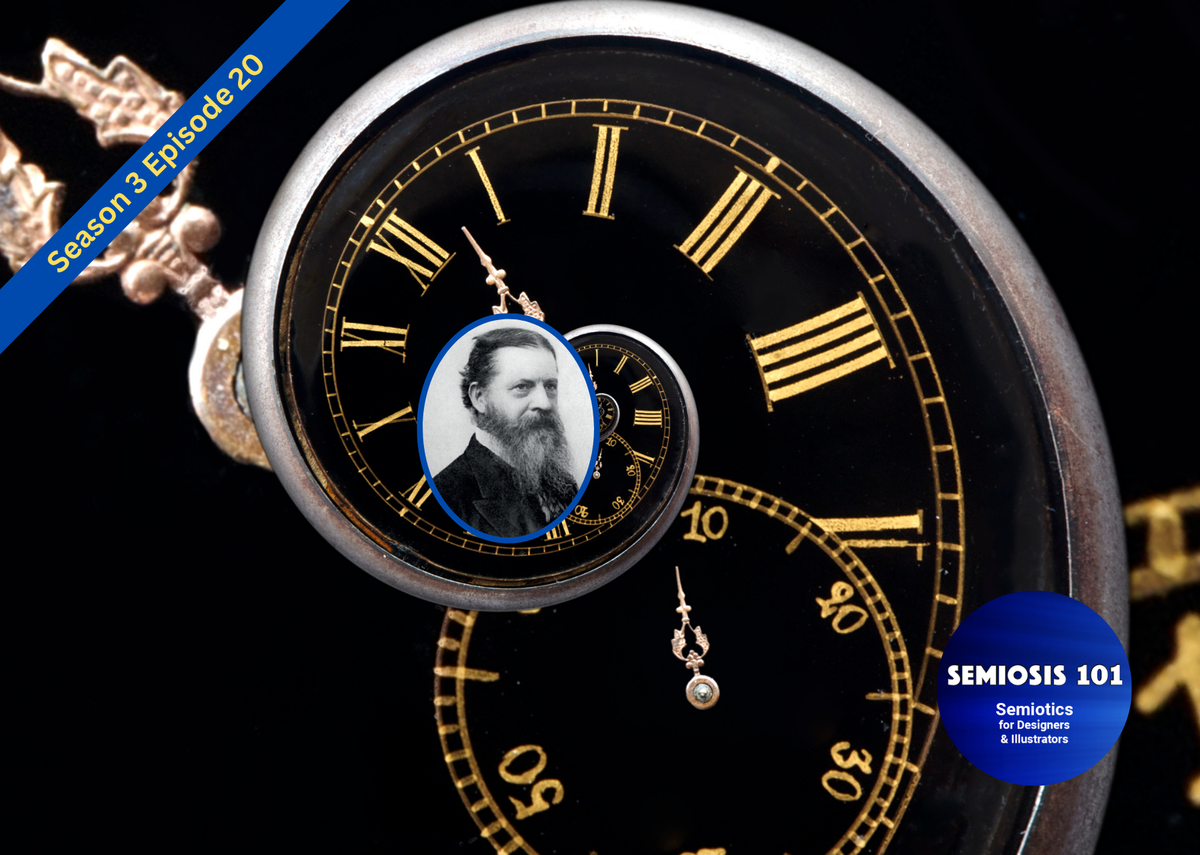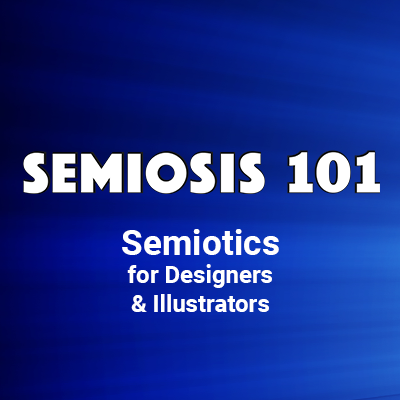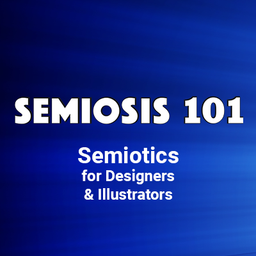Free Semiosis 101 Transcript 3.20:

FOREVER ENCODERS: Why You Have Always Been Working Semiotically
Hello readers.
In this free transcript for the episode published on Semiosis 101 on Weds 13 November 2024, we review season three to demonstrate what we have discovered about Semiosis so far. This season’s theme was Encoding Semiotic Signs into design or illustration work.
Watch the free episode on YouTube for the full impact…
…and here is the episode’s transcript.
How far have we semiotically grown this season? As visual communicators you have always been working semiotically.
“Oh no, we have not!”
Oh yes, you have. Whether designers or illustrators believe it or not, or whether they realise it or not, everything visual they create has the capacity to be meaning-bearing. Semiosis provides a framework to ensure your work visually communicates what it needs to. Let us review how…
In this final season three episode I will review this season to demonstrate what we have discovered about Semiosis so far. This season’s theme was Encoding Semiotic Signs. Therefore, I applied last season’s Semiotic Rosetta Stone metaphor theme into applying Peirce within visual communication.
Season three also became the first season that could be watched months ahead of YouTube, by becoming a Semiosis 101 Producer with a Patreon membership. That means by the time you are watching this episode on YouTube, Patreon Producers are already watching season four episodes …or even season five!
In season three, we have been on a deep dive into ways Semiosis can be applied into design or illustration work. The episodes this season have also led you all to a surprising revelation that you have always been semiotic encoders!
This Semiosis 101 season’s first four episodes helped to orientate you first to how your audience semiotically perceives, understands and interprets what you visualise. We explored this through the pragmatic lenses of how Peirce explains the effects of interpretation on the mind of the audience. Episode 3.2 focussed on the immediate effect of what is seen. Episode 3.3 then focussed on the dynamic effect where more meaning is perceivable, to then end on the final effect in episode 3.4, when the audience is sure of understanding the full meaning. You can watch these episodes individually, or back-to-back in omnibus 3.1 Semiotic Meaning-bearing. These episodes established the perceptual base, to then flip the conversation back to how the creative can begin to encode meaning into any piece of visual communication work, big or small.
In the next three episodes, the focus was on the fundamentals for beginning semiotic encoding… what meaning needs to be encoded, and how to begin! We began with 3.5 Semiotically Building Meaning. This episode reminded you all (or in the case of newbies, introduced you to) a fundamental of Semiosis within Visual Communication Design …Iconic representation. From this micro visual communication building block level, episode 3.6 began to show how meaning and messages can be blocked into visual communication work. Or ENCODED …if you want to be precise. Then in episode 3.7 we cemented this semiotic encoding of meaning firmly within your ideation process. You know, the phase when you began to find ways to answer a brief? More on that next. You can watch episodes 3.5-3.7 individually, or back-to-back in omnibus 3.2 Semiotic Building Blocks.
Ideation, ideation, ideation!
With our turn from interpretation and encoding to ideation, episodes 3.8-3.10 took us into a client’s brief (3.8), your first semiotic idea (3.9), and then semiotic sketching (3.10). These episodes where grouped into a sub-theme of Semiotic Sketching, and demonstrated how Iconic representation has always been present within sketching ideas.
See! I told you you have always been doing this!!
In these three episodes I consolidated the interpretive effect on the mind of the audience, how a basic semiotic sign encodes meaning (even if only as a weak quality), with how creatives begin any design or illustration job. With a rough sketched idea. I took the opportunity to also introduce more of Peirce’s theory into this conversation in designer-centric terms. Check out the episodes in omnibus 3.3 Semiotic Sketching.
Soon Semiosis 101 season four will begin with a preview next episode, but at this point we are only halfway through our review of season three episodes.
With episodes 3.11 - 3.14 we began to join everything together with these new Peircean theoretical terms into designer-centric understanding. Our old favourite panda drawing example was replaced with an example closer to home …the Scouse-Scot visual identity. The Liver Birds image that forms the identity was the main focus. The question was asked, “When is a bird not a bird?” which framed the explanation of how encoded semiotic signs are already in plain view.
What communicational power they have is dependent on the interpreter. So, I used this example to begin our designer-centric explanation of how Peirce defines the triads of sign-action power levels. These are grouped in threes around the semiotics of Perception, Communication and Delivery. As we know, Peirce’s terminology is obtuse, so I began to use analogue terms that are more useful to creatives. In sets of three, these different semiotic sign-action power levels are a result of the interfacing between Perception, Communication and Delivery of the meaning.
Understanding this flow between three inter-dependent functions within semiotic encoding, helped set up the next three episodes. These explained Peirce’s ten semiotic sign classifications. These four episodes on the semiotic power levels can be watched individually, or back-to-back in omnibus 3.4 Interpreting Semiotic Signs.
From these episodes, the season began to turn toward the finish line with three episodes on what Peirce’s ten sign classifications are; why they are important; and more importantly, what they mean to creatives. In episode 3.15 we revisited what I already had begun to explain back in season one. I started to use more and more designer-centric analogue terms for Peirce’s obtuse originals; building on what we had established toward a fresh way of understanding Peirce’s theory. This allowed me to begin discussing in episode 3.16 a new concept with you all, about the delivery of the semiotic meaning. I used the term sign-vehicle specifically for this, so you can picture different modes that semiotic meaning can be delivered by. By episode 3.17, we were then ready to frame ten ways to semiotically encode meaning within your visual language. This explanation was bean-powered without any smelly guffs! So before we sprint to the end of this review, these three episodes are collected in omnibus 3.5 The Ten, YES TEN, Semiotic Signs.
To end season three on Encoding Semiotic Signs, I spent the last two episodes on using examples, one from design and one from illustration, to explain how it all comes together. Just as importantly, in these episodes I reinforced the revelation that whether you are aware or not; whether you believe it or not; or whether you accept it or not …creatives have always been encoding semiotic signs in your work. Some of you doing it better than others.
The two examples I used were Hudson Fuggles’s Christmas by the River 2021 festival designs, and a set of Princess Sazzles picture book illustrations I produced. The two examples could not be further apart. One a set of design outputs to brand an annual Christmas winter festival. The other being a princess on an adventure! In episode 3.18, we saw how a set of picture book illustrations utilised the principles of Semiosis from ideation to finished illustrations.
In episode 3.19 we flipped to a micro semiotic lens to explore and deconstruct where and how Semiosis is present within any piece of design. With the help of a robin, a fox and a stag. These analyses took us down the two different target audiences’ perception levels from Thirdness, through Secondness into Firstness. From an encoding semiotic signs perspective we explored how meaning can be creatively applied within Peirce’s ten classes of semiotic sign.
In the illustration example we semiotically constructed meaning, and then deconstructed where Semiosis is present within design. These episodes, together with next episode’s season four preview, will be available to watch back-to-back in omnibus 3.6 Semiosis In Action. So we end this third season of Semiosis 101 with a fresh revelation on your role as a visual communicator. You have ALWAYS been working semiotically.
Semiosis 101 just helps you to enhance how effective you now want to be in visual communicating. There was a lot to pack into episodes 3.18 and 3.19, but I still only scratched the surface of this analysis. Therefore, as exclusive content for Semiosis 101 Producers with a Patreon membership, I have made a Princess Sazzles semiotic analysis special for illustrators. A design special will be next. Check out the Patreon link below.
Next week we will preview Semiosis 101 season four’s theme for the next 20 episodes. But, if you were a Semiosis 101 Producer you can be watching season four months in advance of YouTube on Patreon. Just saying…
Semiosis 101 Semiotic Design Resources is a reader-supported publication. To receive exclusive posts and support my work, consider becoming a free or paid subscriber. Paid subscribers get name checked on all future Semiosis 101 YouTube episodes.
===Semiosis 101 Patreon Producer==============
Become a Semiosis 101 Patreon Producer and get a named producer credit on future video episodes, plus watch all new episodes months ahead of YouTube.
===Semiosis 101 Patreon Exclusives==============
Watch longer Patreon-exclusive Semiosis 101 episodes on applying Semiosis into design and illustration…
PATEXC001 How does semiotics work in illustration?





